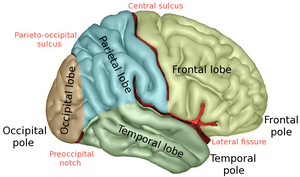Foster-Kennedy syndrome
| Foster–Kennedy syndrome | |
|---|---|
 |
|
| Frontal lobe(on the right) | |
| Specialty |
Neurology |
| Classification |
· ·
|
|---|
Foster–Kennedy syndrome (also known as Gowers–Paton–Kennedy syndrome, Kennedy's phenomenon or Kennedy's syndrome) refers to a constellation of findings associated with tumors of the frontal lobe.
Although Foster–Kennedy syndrome is equated with Kennedy syndrome, it should not be confused with Kennedy disease, which is named for William R. Kennedy.
Pseudo-Foster–Kennedy syndrome is defined as one-sided optic atrophy with papilledema in the other eye but with the absence of a mass.
The syndrome is defined as the following changes:
This syndrome is due to optic nerve compression, olfactory nerve compression, and increased intracranial pressure (ICP) secondary to a mass (such as meningioma or plasmacytoma, usually an olfactory groove meningioma). There are other symptoms present in some cases such as nausea and vomiting, memory loss and emotional lability (i.e., frontal lobe signs).
Brain tumor can be visualized very well on CT scan, but MRI gives better detail and is the preferred study. While awaiting surgical removal, treat any increased intracranial pressure with high-dose steroids (i.e., dexamethasone). Clinical localization of brain tumors may be possible by virtue of specific neurologic deficits or symptom patterns. Tumor at the base of the frontal lobe produces inappropriate behavior, optic nerve atrophy on the side of the tumor, papilledema on the other side, and anosmia (Foster- Kennedy syndrome).
The treatment, and therefore prognosis, varies depending upon the underlying tumour.
The syndrome was first extensively noted by Robert Foster Kennedy in 1911, a British neurologist, who spent most of his career working in the United States of America. However, the first mention of the syndrome came from a William Gowers in 1893. Schultz-Zehden described the symptoms again in 1905. A later description was written by Wilhelm Uhthoff in 1915.
...
Wikipedia
